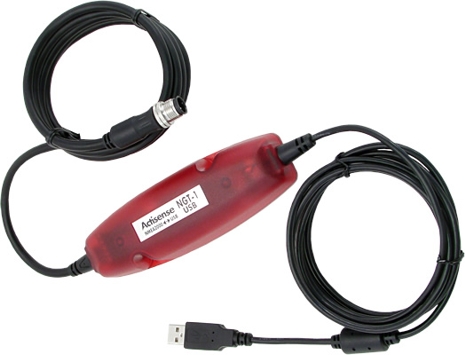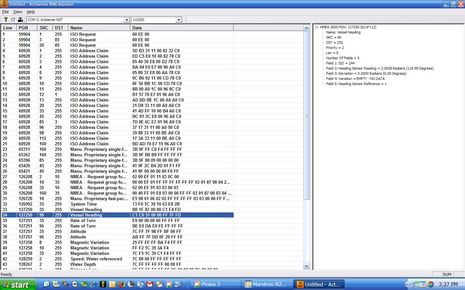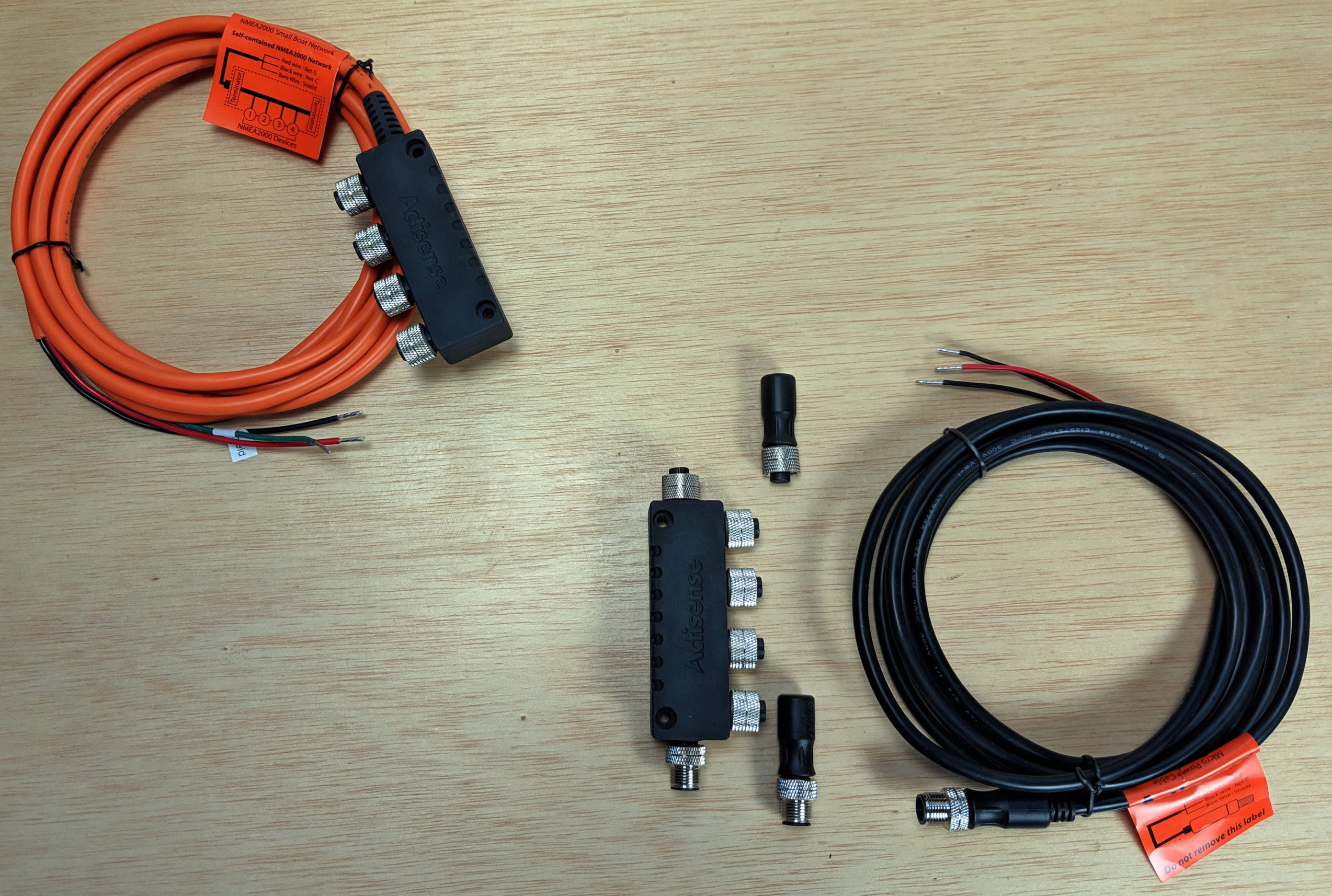Actisense NGT-1 NMEA 2000 gateway, now we’re talking

I’ve got a large NMEA 2000 network set up in the lab now, and it’s giving me a good chance to try out the Actisense NGT-1. It’s fully NMEA certified now, and selling for $200 at some outlets, but I gather that the Third Party Gateway system (formerly known as the Intelligent Gateway) of which it’s a part is not yet fully detailed. In other words, we don’t quite know yet how software that works with it will get NMEA approved and what, if any, restrictions there may be on how it’s sold. For instance, bundling in an NGT-1, or a similar gateway, may required. But I can tell you this: Beta versions of TPG software are starting to look powerful…
 Above (click for bigger) is the latest Beta version of Coastal Explorer 2009 connected to a backbone full of live data via the NGT-1. Yes, the wind display needs work, but the responsiveness to the sensors that do display is excellent (the 115,200 baud rate helps), and think of all the info — engine, tanks, batteries, etc. — that can now be integrated into and/or displayed by CE. All via a simple, robust pipeline with no NMEA 0183 translations needed.
Above (click for bigger) is the latest Beta version of Coastal Explorer 2009 connected to a backbone full of live data via the NGT-1. Yes, the wind display needs work, but the responsiveness to the sensors that do display is excellent (the 115,200 baud rate helps), and think of all the info — engine, tanks, batteries, etc. — that can now be integrated into and/or displayed by CE. All via a simple, robust pipeline with no NMEA 0183 translations needed.
The NGT-1 also seems to work fine with Airmar’s WeatherCaster software (as I illustrated last summer), and seems to be very similar to Airmar’s own U200 Gateway (explained well with Airmar’s other converter/gateways in this PDF). And Actisense has built a simple program for updating the NGT-1 as well as a NMEAReader utility (below) that’s coming along. It’s not yet as informative as Maretron’s N2KAnalyzer (manual here), but then again it can also look at incoming NMEA 0183 data. Maretron’s USB100, incidentally, is both an N2K-to-0183 translator and a gateway (as discussed on the forum), though Maretron has not really opened it to third party developers yet. That may change when the Third Party Gateway rules get fully sorted out. Tomorrow we’ll take a look at a new product that really shows what TPG makes possible.














I have been in contact with Actisense (for quite some time) and hope to get the NGT-1 NMEA 2000 gateway integrated with MacENC.
Please work to get the NGT-1 to work with MacENC. That would make all of us Mac Sailors so very happy!
For MacENC and other DIY’ers out there, http://www.canusb.com is cheaper and has no NMEA-approval issues or restrictions.
(well strike the MacENC part, that was written without thinking 🙂 ) I just wanted to point at a good alternative for DIY’ers who want to get N2K data into their computers…
The Actisense device is also cheap and saves having to implement all the address claims etc.
It is also cheaper than another budget USB-CAN device we were using for N2k
The CanUSB, is a very different thing to the actisense gateway, To make the canUSB work you will have to subscribe to the NMEA 2K program, write a custom low level comms driver to support NMEA 2K, its hardly a “diy” project.
I have had reasonable success with my DIY project using the EasySync Can Plus. I was able to decode a range of N2K data, and put my own data on the bus that was displayed correctly on a Lowrance LMF-400.
However, I am going to try the Actisense NGT-1 and plan to get it working on a low power (4 W) Linux server. It should be a better way to go.
Jon
Is there a way to connect a SimNet install to USB directly? I mean, I could use a simnet to 0183 connector and then 0183 to USB (lame) or SimNet to N2K and then the Actisense (bulky), but is there such a thing as SimNet to USB ?
I’m confused when you say the Maretron USB gateway has not been opened up to 3rd party developers yet. I purchased one with the idea that ANY app on my PC could connect to it and read the N2K data. Are you implying that won’t work?
If the CanUSB device offers the required isolation that keeps all NMEA 2000 products from interfering and damaging each other (I cannot find a datasheet for it on their website to prove this), then for limited ‘Receive only’ operations – where no messages are sent to NMEA 2000 bus, this could be used for ‘DIY’ projects.
However, whilst you can say my comments could be biased, I could never condone using it for sending messages on the NMEA 2000 bus! There are so many issues that could be created that I will not bore you with them all here, but the first one will most certainly concern Address Claiming, which is a complicated business and must be completed (and updated) before you can send any messages on the bus.
The NGT-1 has a full ‘NMEA 2000 stack’ inside it to enable access to the NMEA 2000 data without any of the headaches that will be created by trying to put the ‘stack’ in a PC program – which can never hope to respond in the required time to core bus control messages.
Patrick, For third party applications, the Maretron USB100 is a NMEA 2000 to 0183 translator, which is quite clear in their product descriptions:
“Maretron’s USB100 is a gateway for bridging USB equipment using NMEA 0183 sentences – such as an on-board computer running navigational software – with an NMEA 2000� network.”
http://www.maretron.com/products/usb100.php
The USB100 can be turned into a NMEA 2000 gateway by software commands, which is what happens when you run N2KAnalyzer, but, except for an experiment with Coastal Explorer, Maretron has not made this feature available to third party developers yet.
I think the issues are that the TPG rules aren’t all official yet, and also that the cost of the needed technical support (which Maretron gets high marks for) may exceed the sales value.
Some clarity on the TPG system (thanks to Andy Campbell):
* The NGT-1 is an NMEA 2000 certified gateway, but is not yet certified as a “Third Party Gateway”. To get that, Actisense (or another TPG developer) has to create a test suite and hardware which can prove that all TPG requirements are met, which then has to be tested by the NMEA.
* Actisense, and maybe others, are working on such a test system. Once certified, TPG programs will be tested by a TPG manufacturer and if they pass will be eligible for NMEA Approval (with a $100 fee).
* There will probably not be a requirement that a TPG program be sold with a particular TPG, but the Approval (or whatever NMEA calls it) will be contingent on the program being used with the TPG it was tested with.
Bottom line: To develop an app that reads and/or writes hundreds of different N2K PGNs, thousands of data fields, you just need coding skills, NMEA 2000 Appendix B (available in digital format for $595 plus a NMEA membership), and a relationship with a TPG vendor like Actisense.
I hope I have all that right because it sure sounds good to me. Bring on the apps!
These standards need to be published for Free, like internet standards.
Certification – Great charge for that. How the standard works, rediculous.
I want to see open source hardware available and libraries for development. I could go to Make and buy an Arduino with couple of modules, load up my NMEA libraries and then start to buid in custom functions.
That’s what this needs!
I would like to see a healthy marketplace where I can buy and load applications on my wireless PDA, not so much that I can connect my PC to N2K. Is this effectively bringing us one step closer?
Maybe these things are in the works and not talked about yet, for example …
What’s being done so that PDA’s can use this information? If this gateway outputs proprietary messages onto ethernet, are they compatible enough with the standards that they would be transmitted thru my wifi hub I if I added one to my boats ethernet network? Could that output be read by my wi-fi capable PDA or apple iTouch? Are the proprietary libraries distributed in the technologies compatible for running on a PDA or iTouch? Will I be able to purchase apps from apple store or android store for $10 or will it be $500? Will each app maker support both proprietary vendors libraries (possible right ?), or will boat owners need to wait for a battle to happen and for one to dominate ?
Is a similar but slightly different gateway coming for bluetooth (instead of ethernet) so we can have wireless access to our N2K traffic at much lower power consumption and complexity than having to maintain a WiFi hub on our boats?
Dan, the Actisense NGT-1 is an NMEA 2000 to USB bi-directional gateway, and the proprietary protocol we purely use to transfer the data to the PC, is no problem to a software developer because they use our DLL to easily get to the true NMEA 2000 data contained within it. The DLL is freely available to any software developer and is there to help, not to hide anything.
Once the software developer has received the NMEA 2000 messages from the NGT-1, it is a simple matter of sending that data on Ethernet, which can then become WiFi. I think the article for Avia Design on the main Panbo page talks about just such a product.
As the NGT-1 ends it’s connection at the PC, the format (and compatibility) of the subsequent Ethernet/WiFi messages are determined by the software developer, not Actisense.
I cannot comment on the cost of PC and or iPhone apps that could understand the NMEA 2000 data. Importantly it’s a free market, so if there are enough competing apps out there (in time) then that should help keep the cost down.
As for a ‘battle’, well currently the NGT-1 is the — only — NMEA 2000 to PC gateway that is freely accessible to any PC software developer. The non-PC (Linux, MAC, embedded) software developer needs only sign a simple NDA to get the extra information (normally handled by the DLL). The Actisense NGT-1 is open to any and all software developers – we hate ‘closed shops’ more than most.
NMEA 2000 to bluetooth? If there is a demand for it, then that will normally be satisfied in the end.
Hello,
I would like to second Andy’s comment that the Actisense Dll and access to it makes it almost trivial.
Nick
Dan, I’ve been wondering if a TPG could work smoothly with some of the tablets about to come out, and am thinking that wireless USB might do the trick. Range appears limited but something like the Cables Unlimited device listed here might be used to eliminate the need for a PC and onboard WiFi server:
http://www.everythingusb.com/wireless-usb.html
I think the likes of Actisense should be working on a NMEA 2000 to Ethernet bi-directional gateway which would broadcast UDP Packets. Its interesting to see UDP in action using the demo software from Avia Design, discussed in the next Panbo thread, which uses a PC as a UDP network server.
Running that demo one can see the packets all over the network, including wireless connected laptops. Using Microsoft’s Network Monitor, the UDP payload seems to range from 21 to 23 bytes. Hopefully if Avia were to publish what those packets meant then we are on the way to an informal standard.
Obviously any programmable device, like a Mobile phone, that can access the network via wireless or Ethernet cable could be programmed to use the data.
The process can be bi-directional, in that applications could request information from the gateway or sensor and modify settings such as the frequency packets are sent out.
One advantage of a direct NMEA 2000 to Ethernet gateway would be lower power consumption compared with running a dedicated PC all the time.
Tedgo
I talked with a guy from Actisense today and was told that MaxSea Time Zero won’t be compatible with their NGT-1 until version 2 is released which will be sometime in December.
In the meantime I did learn that the NGW-1-USB was just released for sale in the States last week. This will convert NEMA 2000 to 0183 and vice versa. The cost for the NGW-1-USB is $197 which is $150 cheaper than the same unit from Maretron.
NGW-1 is a nice unit, but doesn’t currently convert every N2K sentence that has an 0183 counterpart. AIS in particular is missing, though an Actisense tech told me to expect AIS translations in a firmware update within the next few weeks. Here is the full list:
http://www.actisense.com/HTML/Products/Gateways/NMEA_2000_Gateway_1/index.php
MacENC version 8 will be released very soon. MacENC version 8 has native support for the Actisense NGT-1 and many N2K PGNs. Will also be testing the NGW-1. Look forward to supporting more N2K functionality going forward.